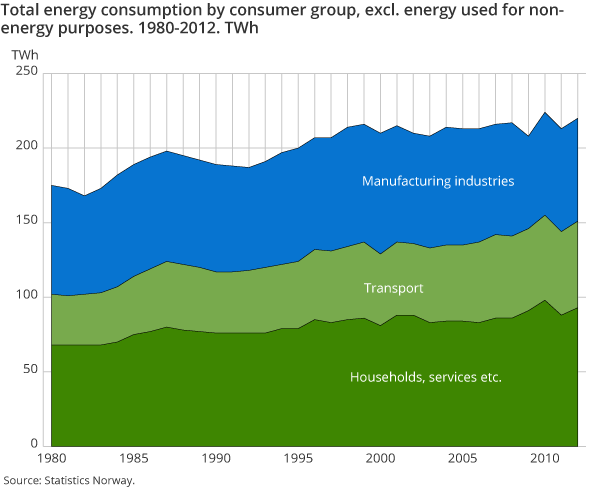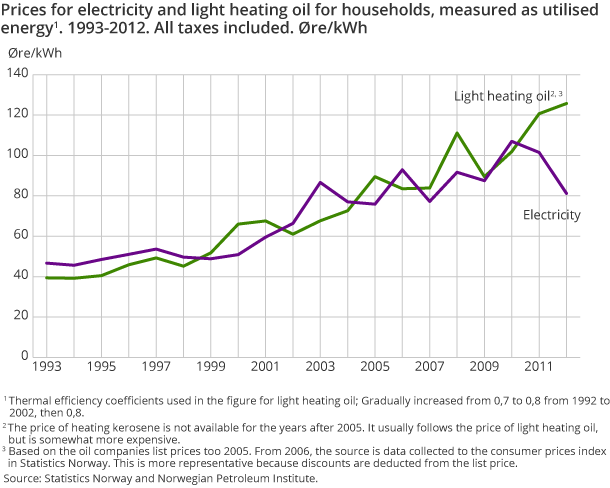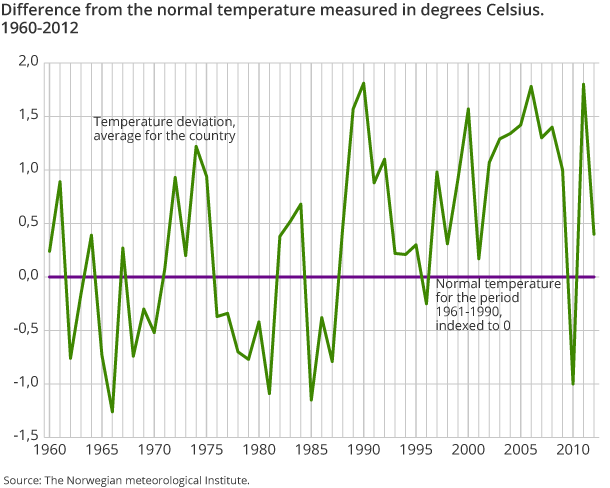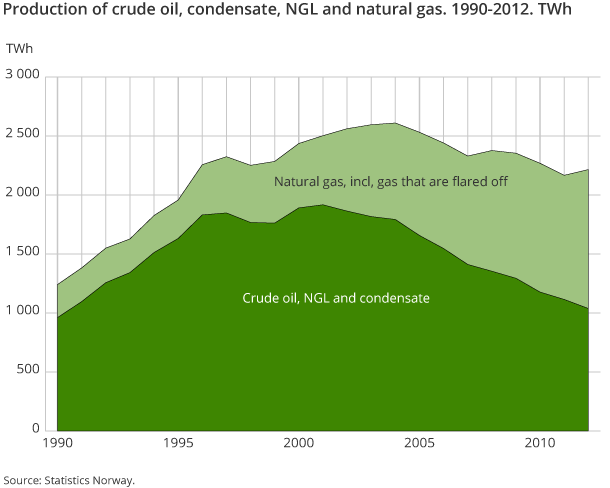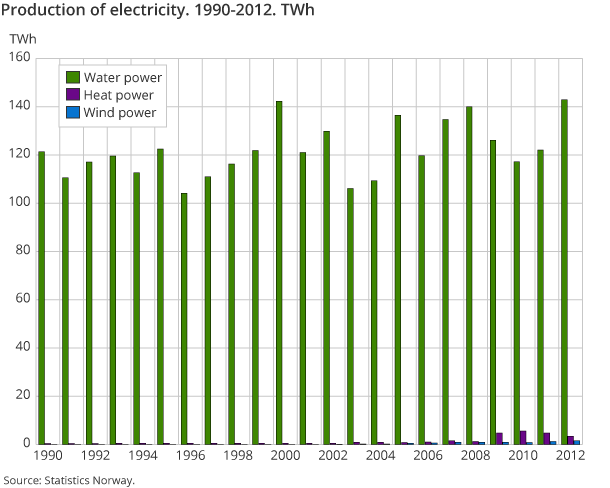Content
Published:
This is an archived release.
Energy consumption up in 2012
Energy consumption in Norway rose by 3 per cent from 2011 to 2012, reaching 220 TWh; the second highest energy consumption ever. The increase reflects the fact that it was colder in 2012 than the year before.
| 2011 | 2012 | Change in per cent | |
|---|---|---|---|
| All energy products | 2011 - 2012 | ||
| 1.1 Primary energy production | 8 329 | 8 583 | 3.1 |
| 2 Imports | 295 | 280 | -5.3 |
| 3 Exports | 7 410 | 7 653 | 3.3 |
| 6 Total energy supply | 1 156 | 1 162 | 0.5 |
| 12 Final consumption including non-energy use | 851 | 866 | 1.7 |
| 13 Manufacturing, mining and quarrying | 248 | 248 | 0.0 |
| 14 Transport | 203 | 208 | 2.3 |
| 15 Other sectors | 316 | 335 | 6.2 |
| 16 Non energy use | 79 | 74 | -5.4 |
Energy consumption increased the most within the household and service sector, with a 6 per cent rise from 2011. A high share of this group’s energy consumption goes towards heating, and temperatures therefore have a significant effect on energy use in this group. For 2012 as a whole, the temperature was 0.4 degrees higher than the normal temperature, compared to 1.8 degrees above normal in 2011.
Increase in electricity consumption
Electricity is the main energy source in Norway, except in transportation. In households and the service sector, electricity makes up about 70 per cent of the energy use. In manufacturing industries, it makes up about 60 per cent. The total electricity consumption in 2012 rose by 3.5 per cent from the previous year. This increase can be attributed to lower electricity prices. Total electricity prices for households in 2012 were on average 81 øre / kWh, compared to around 100 øre per kWh in the preceding years.
In 2012, energy consumption for transport purposes rose by 2 per cent from the year before. Petroleum products such as diesel, gasoline and marine gas oils are the most important energy products used in transportation. However, there was a large increase in the use of natural gas and biofuels for transport in 2012. Sale of biofuels, i.e. biodiesel and bioethanol, rose by about 15 per cent from the previous year, reaching around 180 million litres. This represents about 2.5 per cent of total energy use for transportation purposes.
Increased energy production
The decrease in electricity prices in 2012 is related to high water reservoir levels and record high electricity production. Total electricity production came to 148 TWh. Of this, 97 per cent was hydropower. Otherwise, 1.6 TWh of wind and 3.4 TWh of thermal energy, such as gas power, were produced. There was also a sharp rise in natural gas production in 2012 of 12 per cent from the year before. Traditionally, Norway has been an oil producer, but since 2004 we have seen a trend where gas production has steadily risen while crude oil production has been reduced. In 2012, the production of natural gas exceeded the production of crude oil.
Higher renewable share
Preliminary figures show that Norway's renewable energy share in 2011 was 65 per cent; two percentage points from the target of 67 per cent by 2020. This is a significant increase from 2010, when the renewable share was 61.4 per cent. The increase in 2011 reflects the fact that it was a warm year and that energy use dropped. This made the denominator in the renewable share decrease, while the numerator remained at about the same level. The same happened in 2009, when energy consumption dropped due the financial crisis, and the renewable proportion reached 65 per cent. The renewable share in transportation in 2011 reached 4.1 per cent, which was about 6 percentage points from the target for 2020.
The EU's Renewable Energy Directive Open and readClose
The EU's Renewable Energy Directive came into force inNorwayin 2012, with the goal of a 67.5 per cent renewable energy share for 2020. This is 7.5 percentage points higher than in 2005, when the proportion was about 60 per cent. The Renewable Energy Directive also includes a transport target, which is 10 per cent renewable energy in transport by 2020.Norway's renewable share is calculated based on figures from the energy balance
The statistics is now published as Production and consumption of energy, energy balance and energy account.
Additional information
The statistics are published in spring and autumn. The spring publication is preliminary and aggregated to a larger degree, and only includes figures for energy balance. In the autumn publication, tables are also presented for the energy accounts.
Contact
-
Statistics Norway's Information Centre
E-mail: informasjon@ssb.no
tel.: (+47) 21 09 46 42

